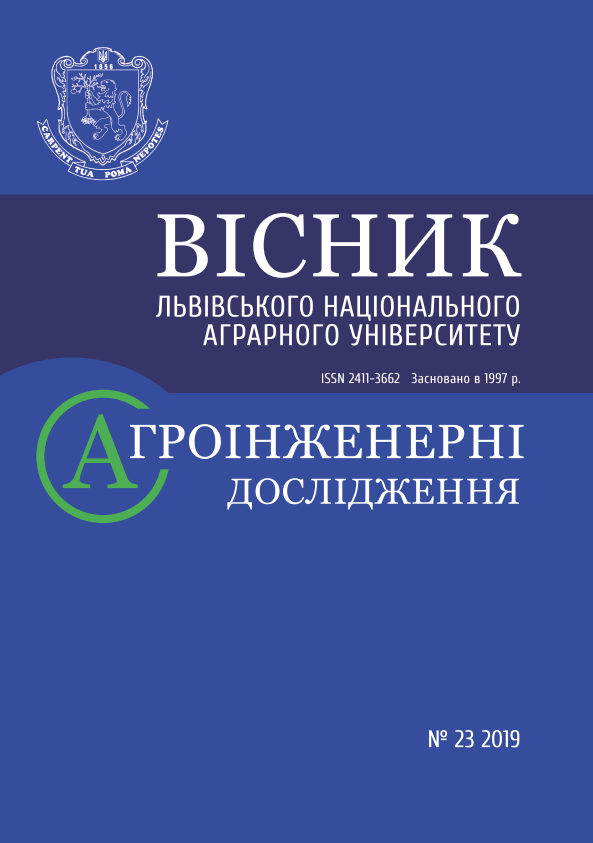ПОЛІПШЕННЯ ХАРАКТЕРИСТИК ПЕРЕТВОРЮВАЧА ЕЛЕКТРОПРИВОДА В ПЕРЕХІДНИХ РЕЖИМАХ
DOI:
https://doi.org/10.31734/agroengineering2019.23.061Keywords:
bridge converter, electric drive, DC motor control, transient modeAbstract
Solving energy saving problems and ensuring safe modes of operation of the DC motor by controlling the optimum mode in a pulsed electric drive.
At present, in the industry, and especially in electric transport, electric motors with direct electric motors are used. The range of application of direct current motors with series excitation motors (DPZ) is rather wide traction electric drive of rolling stock of urban and railway transport. This is due to the fact that the change in the load moment for these mechanisms is in good agreement with the electromechanical characteristics of the DPZ.
A significant factor in increasing the profitability of electric transport in general may be the replacement of an existing traction drive with more modern types.
Simulation models have been developed that allow us to investigate electromechanical processes in a serial DC motor.
Introduction to the circuit of a pulsed regulator diode, which shunts the excitation winding, reduces the rate of attenuation of the current in this winding.
The proposed modernization, which consists in the introduction of diodes in the scheme, allows to use the mode of electrodynamic braking during self-excitation of the electric motor.
The proposed circuit design with the use of energy storage avoids the use of additional independent current sources and simplifies the technical implementation and reduces costs.
The introduction of additional diodes, energy storage, auxiliary and ballast resistors allow to limit the starting current and provide safe operating modes of the elements of the actuator. Also, the voltage on the converter elements is controlled by the additional input of the control unit and does not exceed the maximum permissible values, which ensures safe operation of all network elements.
References
Bleiz, E. S., Zymyn, A. V., & Yvanov, E. S. (1999). Slediashchye pryvody. Moskva: MHTU im. N. E. Baumana.
Borodii, V. A., & Nesterova, O. Yu. (2018). Kompensatsiia rizko-zminnoho strumu yakoria potuzhnykh synkhronnykh pryvodiv zasobamy avtomatychnoi systemy zbudzhennia iz nestandartnym alhorytmom keruvannia. Naukovi jurnal, 1, 72–80.
Vydmysh, A. A., Babii, S. M., & Petrus, V. V. (2012). Teoriia elektropryvoda: Navch. posib. Vinnytsia: VNTU.
Kazachkovskyi, N. N. (2018). Sopostavlenye zakonov chastotnoho upravlenyia na prymere preobrazovatelia chastoty ALTIVAR 21. Hirnycha elektromekhanika ta avtomatyka, 100, 69–72.
Kаzmirеnkо V. F., Leskov, A. H., & Vvedenskyi, V. A. (1993). Systemy slediashchykh pryvodov. Moskva: Energoatomizdat.
Kliuchev, V. Y. (1998). Teoryia elektropryvoda. Moskva: Energoatomizdat.
Solodovnykov, V. V., Konkov, V. H., Sukhanov, V. A., & Sheviakov. O. V. (1991). Mykroprotsessornye avtomatycheskye systemy regulyrovanyia. Moskva: Vyssh. shk.
Podzharenko, V. O., Driuchyn, O. O., & Vasilevskyi, O. V. (2005). Optymizatsiia impulsnoho rehuliuvannia halmuvannia dvyhuna postiinoho strumu. Visnyk Natsionalnoho Universytetu “Lvivska politekhnika”. Seriia: Avtomatyka, vymiriuvannia ta keruvannia, 530, 106–110.
Rozanov, Yu. K., & Florentsev, S. Y. (1997). Sylovaia еlektronyka v elektropryvode. Pryvodnaia tekhnyka, 5, 5–8.
Sposib halmuvannia dvyhuna postiinoho strumu ta prystrii dlia yoho realizatsii: Pat. 47111A Ukraina, MKI N02 RZ/08; opubl.17.06.02, Biul. № 6.
Sposib rehuliuvannia zbudzhennia synkhronnykh mashyn: pat. 135216 Ukraina: № 201813087; zaiavl. 29.12.2018; opubl. 25.06.2019, Biul. № 12.
Fainshtein, V. H., & Fainshtein, E. H. (1966). Mykroprotsessornye systemy upravlenyia tyrystornymy elektropryvodamy. Moskva: Energoatomizdat.
AC Induction Motor Control Using the constant V/f Principle and a Space-vector PWM Algorithm. Retrieved from www.atmel.com/products/ AVR/mc/avr495.pdf/ AVR495.
AC Induction Motor Control Using the constant V/f Principle and a Natural PWM Algorithm. Retrieved from www.atmel.com/products/AVR/mc/ avr494.pdf/ AVR494.
Beshta, A., Aziukovskyi, O., Khudolii, E. (2018). Sober assessment of economic feasibility of renewable energy and vehicle-to-grid technologies in Ukraine. Physical y Chemical Geotechnologies: Materials of the International Scientific & Practical Conference.
Beshta, A., Balakhontsev, A., Khudolii, S. (2019). Performances of Asynchronous Motor within Variable Frequency Drive with Additional Power Source Plugged via Combined Converter (pp. 17-19). Proceedings of the IEEE 6th International Conference on Energy Smart Systems (ESS).
Diachenko, G. G., & Ouriukovskyi, O. O. (2018). Сontrol laws of electric drives as a result of an in-depth kinematic analysis of the delta robot. Naukowyi visnyk Natsionalnoho hirnychoho universytetu, 1, 106–112.
Piriienko, S., Neuburger, M., Po-Wen, Ch. et al. (2018, September). Evaluation of the Small-Scale Wind Turbine Converter’s Efficiency Built with Various Types of Semiconducting Devices. International Conference on Intelligent Energy and Power Systems (IEPS). Kharkiv.
Po-Wen, Ch., Piriienko, S., Ammann, U. et al. (2019). Influence of the Control Strategy on the Efficiency of SynRM Based Small-Scale Wind Generators. International Conference on Industrial Technology (pp. 31-37). Melbourne.
Sensorless control of Two-Phase Brushless DC Motor. Retrieved from: www.atmel.com/products/AVR/mc/avr440.pdf / AVR440.
Yalanskyi, A., & Yalanskyi, O. (2019). Shock-wave diagnostics of voids and assessment of workload of lining of mine workings based on the construction of cartograms. Retrieved from URL: https://doi.org/10.1051/e3sconf/ 201910900116


